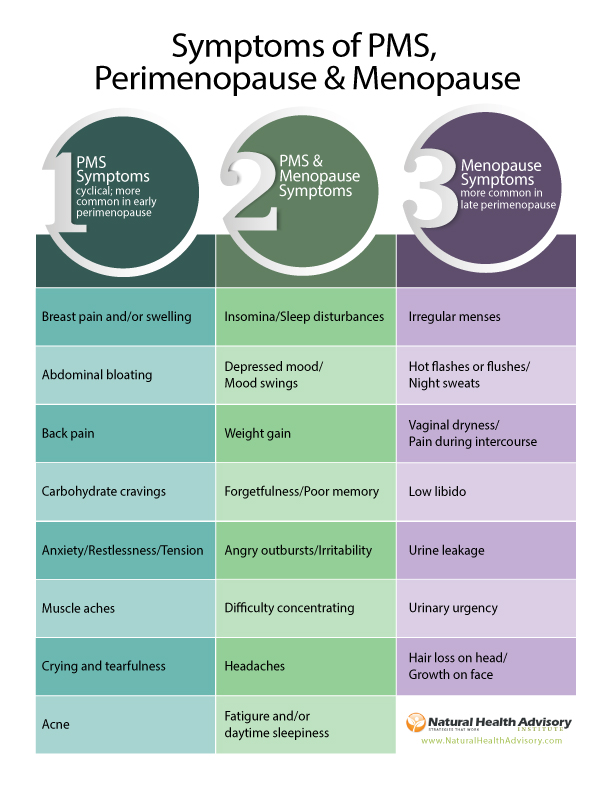Symptoms of Perimenopause—and How to Manage Them with Natural Treatments
For most women, the symptoms of perimenopause can range from acne and carb cravings to hot flashes. Find out more here.
Eek! Do you know what’s worse than PMS? PMS plus menopause symptoms, all at the same time. For many perimenopausal women, this is reality. And, unfortunately, it can be the reality for years. But it doesn’t have to be.
More and more women entering perimenopause are actively educating themselves, questioning their healthcare providers, and searching out natural treatment options for the array of physical, mental, and emotional symptoms they’re experiencing. In this two-part article, you’ll learn about the symptoms of perimenopause, which are a unique combination of PMS and menopause symptoms, and how to manage them using natural perimenopause treatment.
What Is Perimenopause?
Perimenopause, which literally means “about or around menopause,” is the period of months or years leading up to and immediately after menopause, which is the time when a woman’s ovaries stop producing hormones, resulting in the end of her menstrual periods. (Menopause is defined as having no menstrual period for 12 months.)
When Does Perimenopause Start?
A woman’s age is considered a very poor predictor of when perimenopause might start It may be up to 10 years before menopause.1 (The average age of menopause is 51 years, but the normal range is 45 years to 55 years.)
There are two stages of perimenopause—early and late. Early perimenopause—marked by increasing variability in menstrual cycle frequency—typically begins around age 40, although this is highly variable. Technically, a woman can be said to be in early perimenopause if her periods are more than seven days different from normal (e.g., her regular cycles are now every 24 instead of 31 days). Late perimenopause starts when a woman has two or more skipped cycles and a period of no bleeding that lasts more than 60 days.
Hormonal Changes During Perimenopause
While most women believe that perimenopause begins when estrogen levels start to fall, this is not actually the case. In fact, estrogen levels can fluctuate wildly, especially in early perimenopause, sometimes reaching abnormally high temporary levels during the cycle. Estrogen levels will eventually decrease, but not until six months to one year before actual menopause.
Although estrogen and many other hormones, such as follicle stimulating hormone (FSH), change during perimenopause, hormone measurements are not useful for predicting the stage of perimenopause or the final menstrual period. FSH levels can vary significantly across cycles, and the utility of FSH levels for predicting menopause in individual women is therefore low.2
Symptoms of Perimenopause
Perimenopause is the one time in a woman’s life when both PMS and menopause symptoms can occur simultaneously. Early perimenopause is typically characterized by worsening PMS symptoms, which occur during the second half (luteal phase) of the menstrual cycle and typically resolve within four days of bleeding. (Read about treating PMS here and here.)
Late perimenopause, meanwhile, coincides more strongly with typical menopause symptoms (including those shared by both PMS and menopause). For instance, hot flashes and night sweats (vasomotor symptoms), depressive symptoms, and sleep difficulties are much more likely to occur in late perimenopause. The full spectrum of perimenopause symptoms, therefore, incorporates both PMS and menopause symptoms, with some symptoms occurring in both conditions, as reflected in the table, below.
The symptoms of perimenopause can vary in severity and frequency. Each woman’s perimenopause experience is different. Some women report no perimenopause symptoms at all except irregular menstrual periods that eventually stop when they reach menopause. Others will have symptoms that are progressive and problematic for months or years.
Natural Perimenopause Treatment Options
Perimenopause treatment with natural therapies is an excellent way to manage perimenopause symptoms no matter the stage of this transition. In part 2 of this article, you’ll learn about the most-researched and effective natural remedies for perimenopause.
[1] Fertil Steril. 2001 Nov;76(5):874-8.
[2] Medscape. Emedicine. Menopause.
Originally published in 2016, this post is regularly updated.



 MGH Study: Hot Yoga May Help Ease Depression Symptoms, but Be Mindful of Health Concerns
MGH Study: Hot Yoga May Help Ease Depression Symptoms, but Be Mindful of Health Concerns  Ramsay Hunt Syndrome
Ramsay Hunt Syndrome 
Perimenopause is the one time in a woman’s life when both PMS and menopause symptoms can occur simultaneously.
© Ian Allenden | Dreamstime